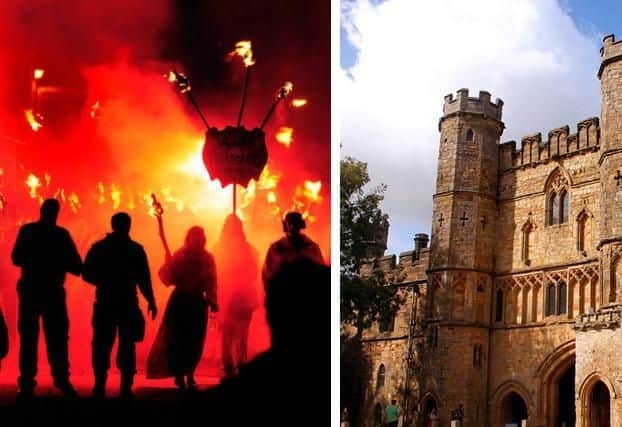The grim cost of gunpowder manufacture in Sussex


I think he was being a tad unkind to the place for Battle is notable not least for the monumental abbey built close to the site of the historic Battle of Hastings.
However, he was most certainly correct about the quality of the gunpowder. Just why Battle and environs came to be pre-eminent in the manufacture of the explosive isn’t clear. However, we do know that Sussex in Elizabethan and Tudor times was home to a thriving iron industry that produced cannons galore. One could assume that where cannons are made it would be logical to also make gunpowder.
Advertisement
Hide AdAdvertisement
Hide AdWhen the county’s natural resources for iron working became exhausted and ordnance manufacturing moved elsewhere, the making of gunpowder could have continued, perhaps as a cottage industry. Concerns about the quality of gunpowder in the early 17th Century led to the industry being regulated. Thus it was that in 1676 John Hammond applied for and was granted a license to build a gunpowder mill near Battle. The site was beside the Asten, a little river that rises by Senlac Hill and eventually empties out into the sea at Combe Haven, east of Hastings.


Soon there five mills in total along the Asten. They had quaint names like Peppering-Eye and The Farthing. Later there were mills at Sedlescombe and Brede. For over two centuries the area was the prime source of gunpowder for the British army and the Royal Navy.
It’s astonishing to think that explosives mixed in the peaceful and sedate Sussex countryside dealt out death and destruction all over the world. Sussex gunpowder would have accompanied Marlborough at Blenheim (1704), Wolfe at Quebec (1759), Clive at Plassey in India (1757), Nelson at Trafalgar (1805) and Wellington at Waterloo (1815).
Up until early Victorian times, gunpowder kegs were transported to the port of Rye to be shipped to wherever British forces needed munitions. The wagons returned with fodder for livestock but we can speculate that they would also on occasion carried contraband such as “baccy” and brandy.
Advertisement
Hide AdAdvertisement
Hide AdDuring the Crimean War (1854-1856), James Morgan supervised the transport of 1,300 barrels of Battle gunpowder by road to Tonbridge where it was loaded onto barges and conveyed via the Medway and Thames to magazines at Erith. For the return journey he loaded up with saltpeter, a vital ingredient in the making of gunpowder. Meanwhile the barrels at Erith would be loaded onto ships in the Thames that then undertook the long voyage to the Black Sea and the Crimea, traversing the Mediterranean and passing Istanbul en route. No doubt Sussex gunpowder was present at the Charge of the Light Brigade!


In 1835 Sussex historian Thomas Horsfield wrote: “Battle is more celebrated for gunpowder than for anything else. The establishment of this dangerous though very profitable manufacture is of early date and is now carried out to very great extent.” He then goes on to report how accidents at the mills seemed to be less numerous than in the past.
This was good news indeed for those past accidents had seen a succession of horrific tragedies. A contemporary newspaper records: “About noon on 27th April 1798, one of the Battle Powder Mills, with a drying house and storeroom nearly adjoining, were, by some unknown accidental communication by fire, blown up with two tremendous explosions and totally destroyed. Three mill men were blown into the air, one was instantly killed; the other two only survived about two hours. The quantity of powder exploded exceeded fifteen tons in weight, and the damage is estimated at upwards of £5,000.
The following extract from the "Burials Register of Battle Church" tells of a disastrous explosion nearly four decades earlier: "5th December 1764. James and Thomas Gillimore, both buried in one grave, who were accidently killed by the blowing up of the Sifting House at Sedlescombe Mill that contained a ton of gunpowder.”
Advertisement
Hide AdAdvertisement
Hide AdThe “Sussex Weekly Advertiser” of 16th July 1787 reports: “Last Wednesday morning, Brede Powdermill belonging to Messrs Brooke, Jenkins and Company, blew up, by which accident two men most miserably burnt, one of whom named James Gutsel lanquished until the next day and then died in great agony while the other lives with little hope of recovery. The deceased, though he had the presence of mind to strip himself of his clothing, was scorched from head to foot and in that wretched condition ran home to his family.”
In 1798 three men at one of the Battle powdermills were killed in a massive blast. Brede was the scene of three mighty explosions in March 1808 that were heard in Lewes, some twenty-five miles distant. “The Advertiser” graphically reported on the death of two workmen and a child: “One of the men named Sinden had his head and limbs separated from his body and carried into a neighbouring wood wherein they were collected and placed together and presented a shocking spectacle. The child was killed in an adjacent cottage.”
I believe there was also a large gunpowder factory established at Maresfield that closed in 1854 after a packing shop blew up and killed several workers.
Let the last word be with Battle, a town with a long Bonfire tradition. Generous quantities of local gunpowder were donated for the purpose of making “Battle Rousers” and squibs and I suspect that mill workers were not averse to “liberating” additional supplies to make Guy Fawkes Night go with an even bigger bang.